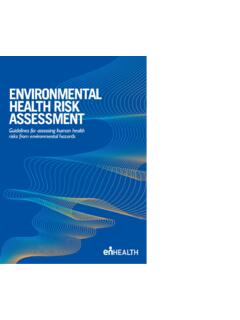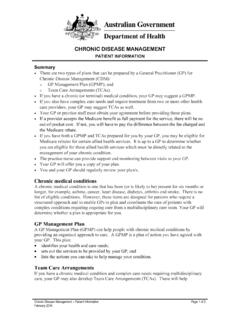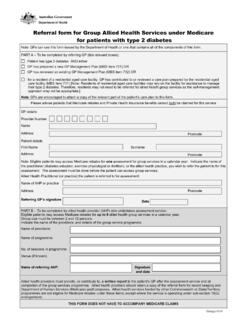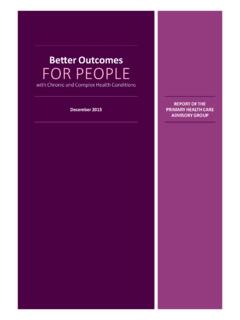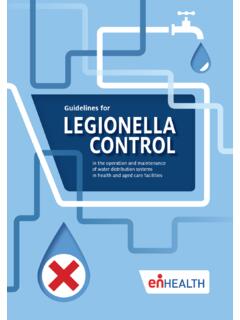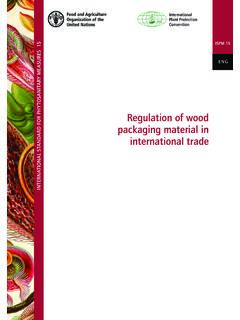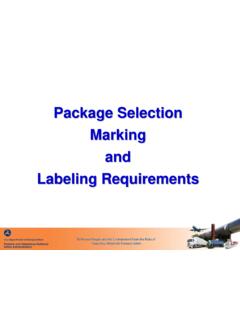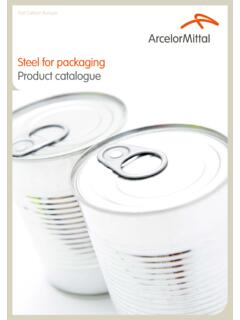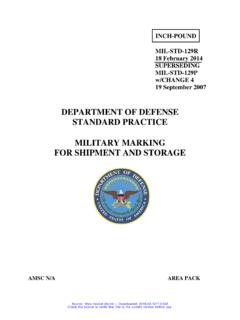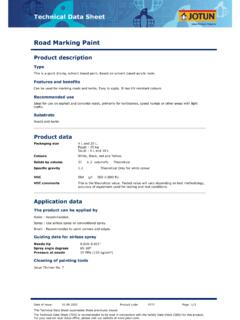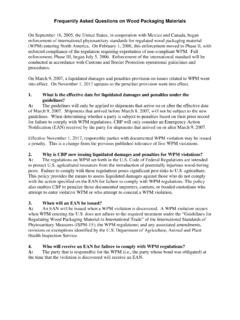Transcription of REQUIREMENTS FOR THE PACKAGING AND TRANSPORT OF …
1 NATIONAL PATHOLOGY ACCREDITATION ADVISORY COUNCIL REQUIREMENTS FOR THE PACKAGING AND TRANSPORT OF PATHOLOGY SPECIMENS AND ASSOCIATED MATERIALS (Fourth Edition 2013) NPAAC Tier 3B Document ii REQUIREMENTS for the PACKAGING and TRANSPORT of Pathology Specimens and Associated Materials Print ISBN: 978-1-74241-917-6 Online ISBN: 978-1-74241-918-3 Publications approval number: 10207 Paper-based publications Commonwealth of Australia 2013 This work is copyright. You may reproduce the whole or part of this work in unaltered form for your own personal use or, if you are part of an organisation, for internal use within your organisation, but only if you or your organisation do not use the reproduction for any commercial purpose and retain this copyright notice and all disclaimer notices as part of that reproduction. Apart from rights to use as permitted by the Copyright Act 1968 or allowed by this copyright notice, all other rights are reserved and you are not allowed to reproduce the whole or any part of this work in any way (electronic or otherwise) without first being given the specific written permission from the Commonwealth to do so.
2 Requests and inquiries concerning reproduction and rights are to be sent to the Online, Services and External Relations Branch, Department of Health, GPO Box 9848, Canberra ACT 2601, or via e-mail to Internet sites Commonwealth of Australia 2013 This work is copyright. You may download, display, print and reproduce the whole or part of this work in unaltered form for your own personal use or, if you are part of an organisation, for internal use within your organisation, but only if you or your organisation do not use the reproduction for any commercial purpose and retain this copyright notice and all disclaimer notices as part of that reproduction. Apart from rights to use as permitted by the Copyright Act 1968 or allowed by this copyright notice, all other rights are reserved and you are not allowed to reproduce the whole or any part of this work in any way (electronic or otherwise) without first being given the specific written permission from the Commonwealth to do so.
3 Requests and inquiries concerning reproduction and rights are to be sent to the Online, Services and External Relations Branch, Department of Health, GPO Box 9848, Canberra ACT 2601, or via e-mail to First published 1987 Second edition 1998 Third edition 2007 reprinted with revisions and name change from Information on the TRANSPORT of Pathology Specimens Fourth edition 2013 reprinted and reformatted to be read in conjunction with the REQUIREMENTS for Medical Pathology Services Australian Government Department of Health REQUIREMENTS for the PACKAGING and TRANSPORT of Pathology Specimens and Associated Materials iii Contents Scope .. vii Abbreviations .. viii Definitions .. ix Introduction ..1 1. Training ..3 Training for staff shipping Specimens by air ..3 2. Hazard classification guide ..4 Biological hazard classes .. 4 Category A ..4 Category B ..4 Exempt (for air TRANSPORT ) or Category C (for surface TRANSPORT ).
4 5 Other hazards .. 5 Figure Hazard classification flow chart ..6 Hazard clarification of common pathology substance .. 7 Table Hazard classifications of some pathology substances .. 7 3. General PACKAGING REQUIREMENTS based on mode of TRANSPORT ..8 PACKAGING .. 8 Labelling and 8 Documentation .. 8 Choosing the mode of TRANSPORT .. 9 Table Matrix for determining mode of general PACKAGING REQUIREMENTS for biological material by various modes of TRANSPORT .. 10 Table Summary of air TRANSPORT REQUIREMENTS .. 11 Figure Labels used in PACKAGING pathology 12 4. Materials not covered elsewhere in these guidelines ..13 Table TRANSPORT guides for other materials related to pathology .. 13 Appendix A The triple PACKAGING system (Normative) ..15 Appendix B Transporting Infectious Substances, Category A, by air (Normative) ..16 Table Examples of containers and PACKAGING for Infectious Substances, Category A.
5 17 Figure Example of correctly marked and labelled package (for Infectious Substances, Category A) with dry ice .. 18 Figure Example of a shipper s declaration (commercially available) .. 19 Appendix C Transporting Biological Substances, Category B, by air (Normative) ..20 Table Examples of containers and PACKAGING for Biological Substances, Category B .. 21 iv REQUIREMENTS for the PACKAGING and TRANSPORT of Pathology Specimens and Associated Materials Figure Example of correctly marked and labelled package for transporting Biological Substances, Category B, by air with dry ice .. 22 Appendix D Transporting exempt Specimens by air (Normative) ..23 Table Examples of containers and PACKAGING for exempt Specimens by air .. 23 Figure Example of correctly labelled package containing exempt human Specimens with dry ice .. 24 Appendix E Transporting Biological Substances, Category B, by Australia Post (Normative).
6 25 Figure Mailing guide for Biological Substances, Category B, in domestic post .. 26 Appendix F Transporting exempt Specimens by post (international and domestic (Normative)..27 Appendix G Transporting dry ice by air (Normative) ..28 Appendix H Indicative examples of infectious substances included in Category A in any form, unless otherwise indicated (Informative ) ..29 Table Examples of Infectious Substances, Category A .. 29 Appendix I Transporting any substances by surface TRANSPORT (foot, trolleys) (Informative) ..31 Table Examples of containers and PACKAGING for double PACKAGING surface TRANSPORT of Specimens .. 31 Appendix J Transporting any substances by surface TRANSPORT (road, rail, ferry) (Informative) ..32 Table Examples of containers and PACKAGING for surface TRANSPORT of Specimens.)
7 33 Figure Diagrammatic example of a common method of transporting clinical Specimens .. 33 Figure Triple PACKAGING .. 34 References ..37 Further REQUIREMENTS for the PACKAGING and TRANSPORT of Pathology Specimens and Associated Materials v The National Pathology Accreditation Advisory Council (NPAAC) was established in 1979 to consider and make recommendations to the Australian, state and territory governments on matters related to the accreditation of pathology laboratories and the introduction and maintenance of uniform standards of practice in pathology laboratories throughout Australia. A function of NPAAC is to formulate Standards and initiate and promote education programs about pathology tests. Publications produced by NPAAC are issued as accreditation material to provide guidance to laboratories and accrediting agencies about minimum Standards considered acceptable for good laboratory practice.
8 Failure to meet these minimum Standards may pose a risk to public health and patient safety. vi REQUIREMENTS for the PACKAGING and TRANSPORT of Pathology Specimens and Associated Materials This page is intentionally blank REQUIREMENTS for the PACKAGING and TRANSPORT of Pathology Specimens and Associated Materials vii Scope The REQUIREMENTS for the PACKAGING and TRANSPORT of Pathology Specimens and Associated Materials is a Tier 3B NPAAC document and must be read in conjunction with the Tier 2 document REQUIREMENTS for Medical Pathology Services. The latter is the overarching document broadly outlining Standards for good medical pathology practice where the primary consideration is patient welfare, and where the needs and expectations of patients, Laboratory staff and referrers (both for pathology requests and inter-Laboratory referrals) are safely and satisfactorily met in a timely manner. Whilst there must be adherence to all the REQUIREMENTS in the Tier 2 document, reference to specific Standards in that document are provided for assistance under the headings in this document.
9 This document provides the REQUIREMENTS for the PACKAGING and transportation of biological Specimens from the point of first collection to the Laboratory site where analytical testing is carried out. Several modes of TRANSPORT may be required, each of which is covered in this document. The following topics are outside the scope of this document: blood and blood products for transfusion see the Australian Red Cross Blood Service documents, Receipt and Use of Blood Service Shippers by External Institutions to TRANSPORT Blood and Blood Products (contact ARCBS1, for more information) TRANSPORT of medical waste refer to relevant jurisdictional legislation REQUIREMENTS for the PACKAGING of genetically modified organisms (GMOs) see the Guidelines for the TRANSPORT of GMOs issued by the Office of the Gene Technology 1 2 viii REQUIREMENTS for the PACKAGING and TRANSPORT of Pathology Specimens and Associated Materials Abbreviations AS Australian Standard GM Genetically Modified GMO Genetically Modified Organism IATA International Air TRANSPORT Association ISO International Organization for Standardization NPAAC National Pathology Accreditation Advisory Council UN United Nations REQUIREMENTS for the PACKAGING and TRANSPORT of Pathology Specimens and Associated Materials ix Definitions Australian Dangerous Goods Code means a code that describes the REQUIREMENTS and recommendations for the TRANSPORT of dangerous goods by road and rail.
10 Concentrated formalin means the common name for (usually) 40% formaldehyde gas dissolved in water. Dangerous goods means articles or substances that are capable of posing a risk to health, safety, property or the environment. Dry ice means solidified carbon dioxide that changes from solid to gas at normal atmospheric conditions. The carbon dioxide gas can lead to the displacement of oxygen resulting in asphyxiation. If improperly packaged ( gas cannot escape) the carbon dioxide gas will pressurise the container, potentially causing the container to explode. The United Nations (UN) number for dry ice is UN 1845. Dry shippers means large dewar (vacuum) flasks that are designed for the safe shipment of Specimens at liquid nitrogen temperatures without the risk of spilling liquid nitrogen. When prepared correctly, a dry shipper does not contain any free liquid nitrogen. Formal saline means formalin buffered with salt solutions, usually sodium phosphate dibasic and sodium phosphate monobasic, to give a solution with a pH of The most common strength used in pathology is 10% neutral buffered formalin, which contains 10% concentrated formalin, or just 4% formaldehyde.
